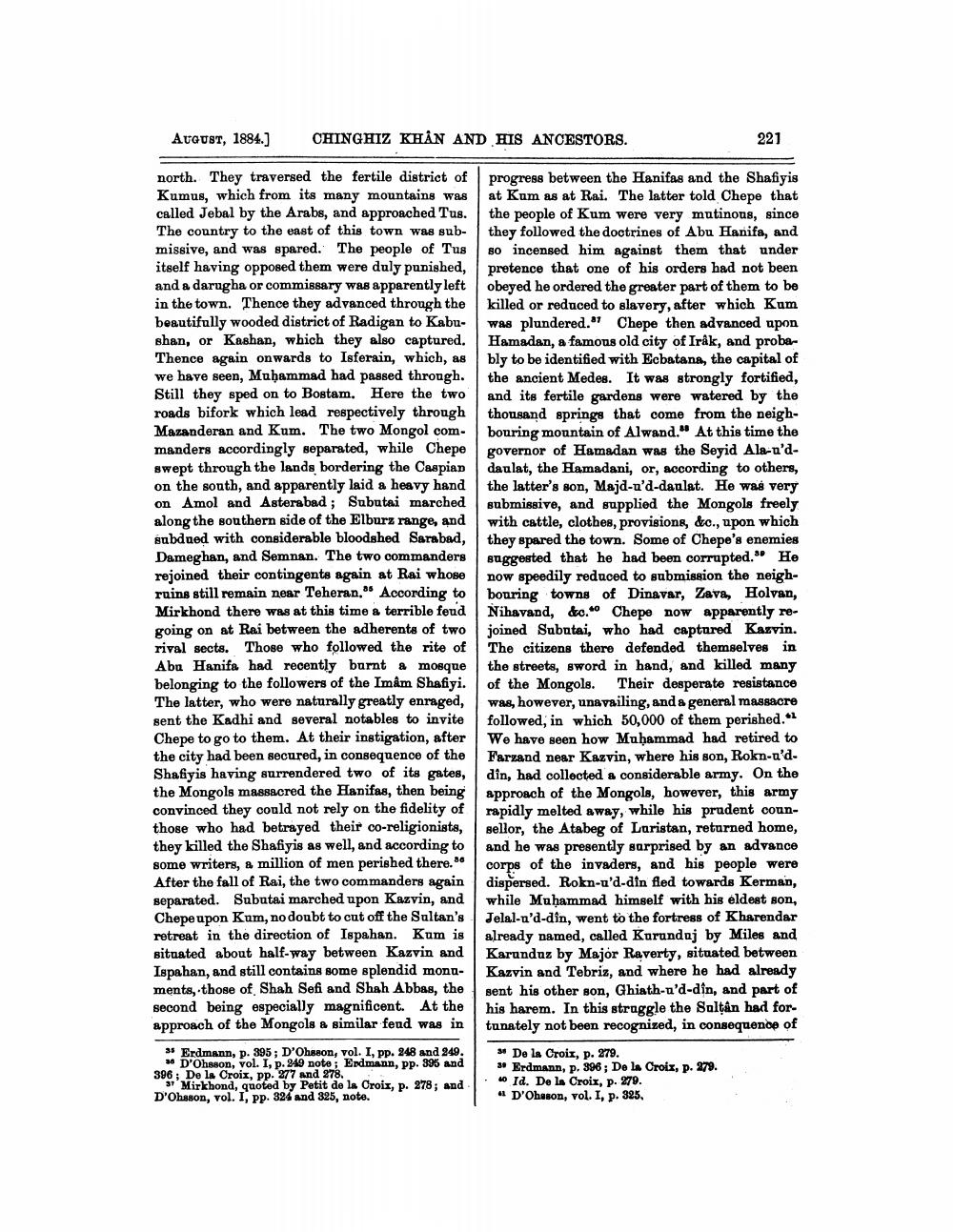________________
AUGUST, 1884.]
CHINGHIZ KHAN AND HIS ANCESTORS.
north. They traversed the fertile district of Kumus, which from its many mountains was called Jebal by the Arabs, and approached Tus. The country to the east of this town was submissive, and was spared. The people of Tus itself having opposed them were duly punished, and a darugha or commissary was apparently left in the town. Thence they advanced through the beautifully wooded district of Radigan to Kabushan, or Kashan, which they also captured. Thence again onwards to Isferain, which, as we have seen, Muḥammad had passed through. Still they sped on to Bostam. Here the two roads bifork which lead respectively through Mazanderan and Kum. The two Mongol commanders accordingly separated, while Chepe swept through the lands bordering the Caspian on the south, and apparently laid a heavy hand on Amol and Asterabad; Subutai marched along the southern side of the Elburz range, and subdued with considerable bloodshed Sarabad, Dameghan, and Semnan. The two commanders rejoined their contingents again at Rai whose ruins still remain near Teheran," According to Mirkhond there was at this time a terrible feud going on at Rai between the adherents of two rival sects. Those who followed the rite of Abu Hanifa had recently burnt a mosque belonging to the followers of the Imam Shafiyi. The latter, who were naturally greatly enraged, sent the Kadhi and several notables to invite Chepe to go to them. At their instigation, after the city had been secured, in consequence of the Shafiyis having surrendered two of its gates, the Mongols massacred the Hanifas, then being convinced they could not rely on the fidelity of those who had betrayed their co-religionists, they killed the Shafiyis as well, and according to some writers, a million of men perished there." After the fall of Rai, the two commanders again separated. Subutai marched upon Kazvin, and Chepe upon Kum, no doubt to cut off the Sultan's retreat in the direction of Ispahan. Kum is situated about half-way between Kazvin and Ispahan, and still contains some splendid monuments, those of Shah Sefi and Shah Abbas, the second being especially magnificent. At the approach of the Mongols a similar feud was in
35 Erdmann, p. 395; D'Ohsson, vol. I, pp. 248 and 249. 36 D'Ohsson, vol. I, p. 249 note; Erdmann, pp. 395 and 396; De la Croix, pp. 277 and 278.
37 Mirkhond, quoted by Petit de la Croix, p. 278; and D'Ohsson, vol. I, pp. 324 and 325, note.
221
progress between the Hanifas and the Shafiyis at Kum as at Rai. The latter told Chepe that the people of Kum were very mutinous, since they followed the doctrines of Abu Hanifa, and so incensed him against them that under pretence that one of his orders had not been obeyed he ordered the greater part of them to be killed or reduced to slavery, after which Kum was plundered." Chepe then advanced upon Hamadan, a famous old city of Iråk, and probably to be identified with Ecbatana, the capital of the ancient Medes. It was strongly fortified, and its fertile gardens were watered by the thousand springs that come from the neighbouring mountain of Alwand." At this time the governor of Hamadan was the Seyid Ala-u'ddaulat, the Hamadani, or, according to others, the latter's son, Majd-u'd-daulat. He was very submissive, and supplied the Mongols freely with cattle, clothes, provisions, &c., upon which they spared the town. Some of Chepe's enemies suggested that he had been corrupted." He now speedily reduced to submission the neighbouring towns of Dinavar, Zava, Holvan, Nihavand, &c. Chepe now apparently rejoined Subutai, who had captured Kazvin. The citizens there defended themselves in the streets, sword in hand, and killed many of the Mongols. Their desperate resistance was, however, unavailing, and a general massacre followed, in which 50,000 of them perished.*1 We have seen how Muhammad had retired to Farzand near Kazvin, where his son, Rokn-u'ddin, had collected a considerable army. On the approach of the Mongols, however, this army rapidly melted away, while his prudent counsellor, the Atabeg of Luristan, returned home, and he was presently surprised by an advance corps of the invaders, and his people were dispersed. Rokn-u'd-din fled towards Kerman, while Muḥammad himself with his eldest son, Jelal-u'd-din, went to the fortress of Kharendar already named, called Kurandaj by Miles and Karunduz by Major Raverty, situated between Kazvin and Tebriz, and where he had already sent his other son, Ghiath-u'd-din, and part of his harem. In this struggle the Sultan had fortunately not been recognized, in consequence of
40
3 De la Croix, p. 279.
30 Erdmann, p. 396; De la Croix, p. 279.
40 Id. De la Croix, p. 279.
D'Ohsson, vol. I, p. 325,




